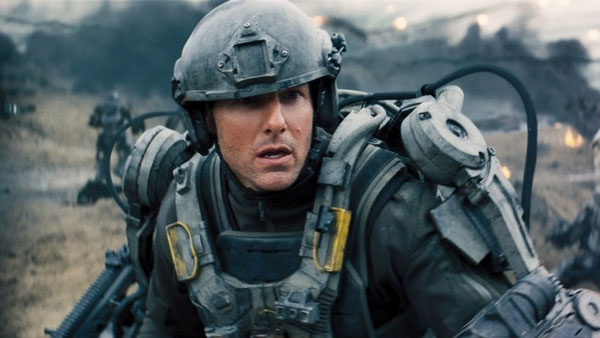Edge of Tomorrow Review
With the exception, maybe, of Scott Pilgrim vs. the World, no film has ever so closely replicated what it’s like to actually play a video game than Doug Liman’s All You Need Is Kill Live/Die/Repeat Edge of Tomorrow. And with the exception of Scott Pilgrim, no film that’s either explicity based on a video game or more tangentially based on the idea of video games (like this one) is smarter than Edge of Tomorrow. But in the land of the blind, the one-eyed man is king, and being one of the smartest video game movies ever made doesn’t necessarily make a movie smart.
The film is basically a riff on Duncan Jones’ Source Code but set during an alien invasion. It begins with some exposition: A crusading species has invaded Earth and taken control of most of Europe. For a while, it seemed mankind was fighting back in vain, unable to kill even one of these creatures. But the famous Battle of Verdun changed the tide somewhat and gave humanity a hero in the form of Rita Vrataski (Emily Blunt), who leads mankind in its first victory in this planetary war.
On the precipice of the next big battle (for London), military PR shill Bill Cage (Tom Cruise) is thrown to the wolves by his commanding officer. He’s heading to the front line and killed just minutes after figuring out how to turn off the safety on his mechanized suit weapon (think Avatar).
But wait: Cage is back on a tarmac about to be verbally accosted by his platoon’s leader…again. Now he’s back on his transport vehicle. Back in battle. Dead again. Alive again. What???
The reason behind this morbid Groundhog Day doesn’t make very much sense, but thankfully, neither Liman nor the film’s screenwriting team (Christopher McQuarrie, Jez Butterworth, and John-Henry Butterworth) dwells on it too much. Edge of Tomorrow isn’t concerned with the why, but rather what Cage and Vrataski do with all that time. It’s not a deal-breaker necessarily—the way it just plows through reason. But the fact that it does so in a way that virtually eliminates the film’s stakes for the majority of the running time is something no screenplay could recover from.
When I say the film replicates the experience of playing a video game, it’s because of this premise. Work toward a goal, make a mistake, lose a life, start back at the beginning. It’s Super Mario Brothers: Invasion. Occasionally, you’ll encounter a boss or hit a checkpoint of sorts, but you’ll play the level again and again, finding patterns that advance you further each time. Again, it’s interesting to see a talented filmmaker like Liman and stars like Blunt (who’s great) and Cruise (who’s fine) attempt to mine this material and this style of storytelling for something meaningful, but it’s fool’s gold they dig up—mindless engery cinema.
All that said, it’s not a boring film to watch. There’s solid chemistry between Cruise and Blunt (who has great chemistry with anyone she shares a screen with because she’s Emily Blunt and because she’s awesome), and there’s some clever bits along the way that clue you in to just how many times these characters have performed this exhausting exercise. Edge of Tomorrow might have been more noteworthy if it disposed of the alien thing altogether and asked its characters to solve a mystery or even something hilariously innocuous like a jigsaw puzzle, but big and loud is a business imperative. So this is the film we have, and while it doesn’t live up to its potential, it’s nevertheless better than most of its ilk. A perfectly watchable, wildly imperfect movie.

















One Response to Edge of Tomorrow Review